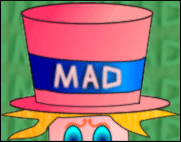The Phrase 'as Mad as a Hatter'
Created | Updated Jul 23, 2007

Mad as a Hatter
The phrase 'mad as a hatter', like most phrases, has its basis in a curious and long forgotten fact.
In his novel of 1850 Pendennis, William Thackeray uses the phrase to imply anger, as opposed to madness:
We were talking about it at mess, yesterday, and chaffing Derby Oaks - until he was as mad as a hatter.
The phrase was later used to imply madness, or at least eccentricity, as demonstrated by Tom Brown's Schooldays, when Thomas Hughes described someone as:
a very good fellow, but as mad as a hatter.
Dementia was indeed a common ailment among 19th Century hatmakers, as exemplified by the most famous literary example, the lunatic host of the tea party in Lewis Carroll's Alice In Wonderland: the Mad Hatter himself. The earliest mention of a 'mad hatter' appears to refer to one Robert Crab, a 17th Century eccentric living at Chesham, England. He gave all his goods to the poor and lived on dock leaves and grass. Carroll, however, seems to have based his mad hatter not on Robert Crab, but on a certain Theophilus Carter - not a hatter but a furniture dealer - who was known locally as the Mad Hatter, partly because he always wore a top hat, and partly because he was quite an eccentric and produced some wacky inventions. Makers of felt hats would indeed often drool, tremble, talk to themselves and have bouts of severe paranoia, for reasons that will become clear. Both in Europe and North America they were the eccentrics and madmen of the clothing trades, which gave rise to the phrase as used today.
These hatmakers used the softest of felts for their hats and these felts were originally derived from one of two animal pelts: beaver or rabbit. Beaver was the pelt of choice, though rabbits were more plentiful, hence cheaper, so were often used. However, rabbits had very short hairs that required treatment. To soften and mat the hair, hatmakers used a heated solution of mercury (II) nitrate. Every one of these hatmakers had a vat of this nitrate heating away in his workshop. This process was known as 'carroting', as the treated fur turned orange. Not being an era known for its decent working conditions, ventilation was poor.
What these hatmakers did not know was that their mercurous nitrate, though inorganic, was still highly toxic. Though not as deadly as its organic cousins, severe renal and gastrointestinal problems can occur. To add to that unpleasant prospect, given that mercury tends to travel rapidly through the bloodstream to the brain, other symptoms of poisoning also include drooling, trembling, memory loss and psychotic behaviour. The hatmakers, without knowing it, were poisoning themselves in their workshops in their efforts to craft felt hats for the people about town. The common sight of these muttering tradesman gave birth to the phrase 'mad as a hatter' and, later, Carroll's demented character.
Due to the trembling, this condition also became known as St Vitus' dance. It was thought that joyous dancing in front of this Sicilian saint's statue could bring good fortune throughout the year. The trembling, poisoned hatmakers were said to resemble these dancing devotees seeking a good year. In Danbury, Connecticut, one of the centres of the hat trade in the the United States, the conditon became known as 'the Danbury Shakes'. To add to this, the people who wore the hats themselves would often develop similar symptoms.
All for a fur-lined top hat.

